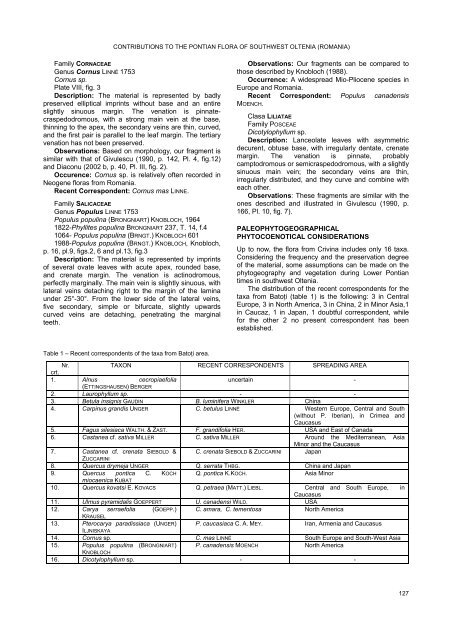Create successful ePaper yourself
Turn your PDF publications into a flip-book with our unique Google optimized e-Paper software.
CONTRIBUTIONS TO THE PONTIAN FLORA OF SOUTHWEST OLTENIA (ROMANIA)<br />
Family CORNACEAE<br />
Genus Cornus LINNÉ 1753<br />
Cornus sp.<br />
Plate V<strong>II</strong>I, fig. 3<br />
Description: The material is represented by badly<br />
preserved elliptical imprints without base and an entire<br />
slightly sinuous margin. The venation is pinnatecraspedodromous,<br />
with a strong main vein at the base,<br />
thinning to the apex, the secondary veins are thin, curved,<br />
and the first pair is parallel to the leaf margin. The tertiary<br />
venation has not been preserved.<br />
Observations: Based on morphology, our fragment is<br />
similar with that of Givulescu (1990, p. 142, Pl. 4, fig.12)<br />
and Diaconu (2002 b, p. 40, Pl. <strong>II</strong>I, fig. 2).<br />
Occurence: Cornus sp. is relatively often recorded in<br />
Neogene floras from Romania.<br />
Recent Correspondent: Cornus mas LINNE.<br />
Family SALICACEAE<br />
Genus Populus LINNE 1753<br />
Populus populina (BRONGNIART) KNOBLOCH, 1964<br />
1822-Phyllites populina BRONGNIART 237, T. 14, f.4<br />
1064- Populus populina (BRNGT.) KNOBLOCH 601<br />
1988-Populus populina (BRNGT.) KNOBLOCH, Knobloch,<br />
p. 16, pl.9, figs.2, 6 and pl.13, fig.3<br />
Description: The material is represented by imprints<br />
of several ovate leaves with acute apex, rounded base,<br />
and crenate margin. The venation is actinodromous,<br />
perfectly marginally. The main vein is slightly sinuous, with<br />
lateral veins detaching right to the margin of the lamina<br />
under 25°-30°. From the lower side of the lateral veins,<br />
five secondary, simple or bifurcate, slightly upwards<br />
curved veins are detaching, penetrating the marginal<br />
teeth.<br />
Observations: Our fragments can be compared to<br />
those described by Knobloch (1988).<br />
Occurrence: A widespread Mio-Pliocene species in<br />
Europe and Romania.<br />
Recent Correspondent: Populus canadensis<br />
MOENCH.<br />
Clasa LILIATAE<br />
Family POSCEAE<br />
Dicotylophyllum sp.<br />
Description: Lanceolate leaves with asymmetric<br />
decurent, obtuse base, with irregularly dentate, crenate<br />
margin. The venation is pinnate, probably<br />
camptodromous or semicraspedodromous, with a slightly<br />
sinuous main vein; the secondary veins are thin,<br />
irregularly distributed, and they curve and combine with<br />
each other.<br />
Observations: These fragments are similar with the<br />
ones described and illustrated in Givulescu (1990, p.<br />
166, Pl. 10, fig. 7).<br />
PALEOPHYTOGEOGRAPHICAL<br />
PHYTOCOENOTICAL CONSIDERATIONS<br />
Up to now, the flora from Crivina includes only 16 taxa.<br />
Considering the frequency and the preservation degree<br />
of the material, some assumptions can be made on the<br />
phytogeography and vegetation during Lower Pontian<br />
times in southwest Oltenia.<br />
The distribution of the recent correspondents for the<br />
taxa from Batoţi (table 1) is the following: 3 in Central<br />
Europe, 3 in North America, 3 in China, 2 in Minor Asia,1<br />
in Caucaz, 1 in Japan, 1 doubtful correspondent, while<br />
for the other 2 no present correspondent has been<br />
established.<br />
Table 1 – Recent correspondents of the taxa from Batoţi area.<br />
Nr.<br />
TAXON RECENT CORRESPONDENTS SPREADING AREA<br />
crt.<br />
1. Alnus cecropiaefolia<br />
uncertain -<br />
(ETTINGSHAUSEN) BERGER<br />
2. Laurophyllum sp. - -<br />
3. Betula insignis GAUDIN B. luminifera WINKLER China<br />
4. Carpinus grandis UNGER C. betulus LINNÉ Western Europe, Central and South<br />
(without P. Iberian), in Crimea and<br />
Caucasus<br />
5. Fagus silesiaca WALTH. & ZAST. F. grandifolia HER. USA and East of Canada<br />
6. Castanea cf. sativa MILLER C. sativa MILLER Around the Mediterranean, Asia<br />
Minor and the Caucasus<br />
7. Castanea cf. crenata SIEBOLD & C. crenata SIEBOLD & ZUCCARINI Japan<br />
ZUCCARINI<br />
8. Quercus drymeja UNGER Q. serrata THBG. China and Japan<br />
9. Quercus pontica C. KOCH Q. pontica K.KOCH. Asia Minor<br />
miocaenica KUBAT<br />
10. Quercus kovatsi E. KOVACS Q. petraea (MATT.) LIEBL. Central and South Europe, in<br />
Caucasus<br />
11. Ulmus pyramidalis GOEPPERT U. canadensi WILD. USA<br />
12. Carya serraefolia (GOEPP.) C. amara, C. tementosa North America<br />
KRAUSEL<br />
13. Pterocarya paradissiaca (UNGER) P. caucasiaca C. A. MEY. Iran, Armenia and Caucasus<br />
ILJNISKAYA<br />
14. Cornus sp. C. mas LINNÉ South Europe and South-West Asia<br />
15. Populus populina (BRONGNIART) P. canadensis MOENCH North America<br />
KNOBLOCH<br />
16. Dicotylophyllum sp. - -<br />
127

















